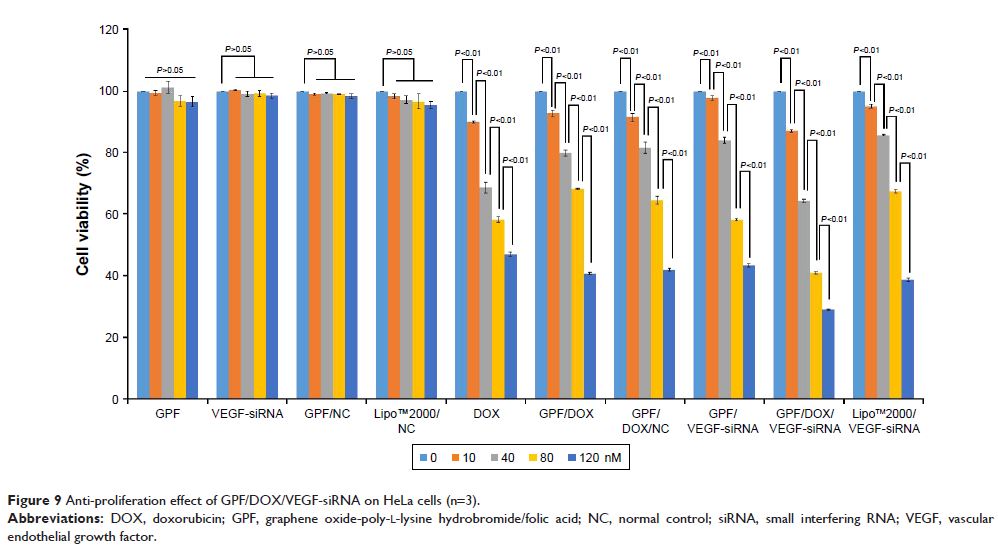108605
论文已发表
注册即可获取德孚的最新动态
IF 收录期刊
- 3.4 Breast Cancer (Dove Med Press)
- 3.2 Clin Epidemiol
- 2.6 Cancer Manag Res
- 2.9 Infect Drug Resist
- 3.7 Clin Interv Aging
- 5.1 Drug Des Dev Ther
- 3.1 Int J Chronic Obstr
- 6.6 Int J Nanomed
- 2.6 Int J Women's Health
- 2.9 Neuropsych Dis Treat
- 2.8 OncoTargets Ther
- 2.0 Patient Prefer Adher
- 2.2 Ther Clin Risk Manag
- 2.5 J Pain Res
- 3.0 Diabet Metab Synd Ob
- 3.2 Psychol Res Behav Ma
- 3.4 Nat Sci Sleep
- 1.8 Pharmgenomics Pers Med
- 2.0 Risk Manag Healthc Policy
- 4.1 J Inflamm Res
- 2.0 Int J Gen Med
- 3.4 J Hepatocell Carcinoma
- 3.0 J Asthma Allergy
- 2.2 Clin Cosmet Investig Dermatol
- 2.4 J Multidiscip Healthc

通过纳米氧化石墨烯共同递送多柔比星和抗 VEGF siRNA,用于体外和体内增强癌症治疗
Authors Sun Q, Wang X, Cui C, Li J, Wang Y
Received 18 January 2018
Accepted for publication 8 March 2018
Published 27 June 2018 Volume 2018:13 Pages 3713—3728
DOI https://doi.org/10.2147/IJN.S162939
Checked for plagiarism Yes
Review by Single-blind
Peer reviewers approved by Dr Mohankandhasamy Ramasamy
Peer reviewer comments 3
Editor who approved publication: Dr Linlin Sun
Background: Graphene oxide (GO) has attracted intensive interest in biological and
medical fields in recent years due to its unique physical, chemical, and
biological properties. In our previous work, we proved that GO could deliver
small interfering RNA (siRNA) into cells and downregulate the expression of the
desired gene.
Methods: This study investigated the potential of a modified GO nanocarrier
for co-delivery of siRNA and doxorubicin (DOX) for enhanced cancer therapy.
Fourier transform infrared spectroscopy, laser particle size analyzer,
UV-visible spectroscopy, gel electrophoresis retardation, and in vitro release
assay were studied.
Results: The results of real-time polymerase chain reaction revealed that
the expression of vascular endothelial growth factor (VEGF) mRNA was decreased
46.84%±3.72% (mean ± SD). Enzyme-linked immunosorbent assay indicated that the
expression of VEGF protein was downregulated to 52.86%±1.10% (mean ± SD) in
vitro. In vivo tumor growth assay GO-poly-L-lysine hydrobromide/folic acid
(GPF)/DOX/siRNA exhibited gene silencing and tumor inhibition (66.95%±2.35%,
mean ± SD) compared with naked siRNA (1.62%±1.47%, mean ± SD) and DOX
(33.63%±5.85%, mean ± SD). GPF/DOX/siRNA exhibited no testable
cytotoxicity.
Conclusion: The results indicated that co-delivery of siRNA and DOX by GPF
could be a promising application in tumor clinical therapy.
Keywords: graphene oxide, siRNA delivery, co-delivery carrier, cervical
carcinoma
